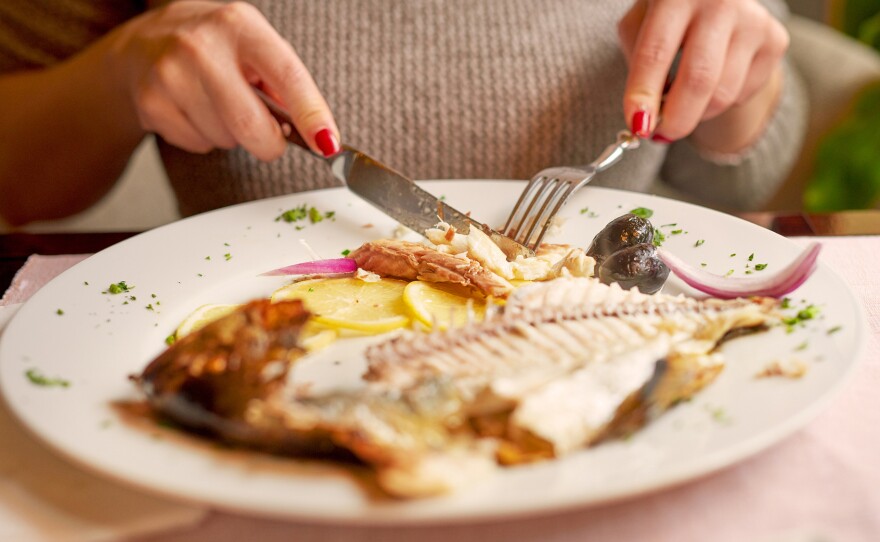For many pregnant women, understanding what seafood is safe and healthy, and what should be avoided because of mercury concerns comes with a lot of hand-wringing. In part, that's because the federal government's advice on the matter, first issued in 2004, has long been criticized as unclear.
That guidance has included advice on how much seafood to eat, and which species pregnant and nursing women should avoid over concerns about mercury contamination.
But critics say the government advisory has done more harm than good, scaring many pregnant and nursing women (and let's be real — pretty much everyone else) away from eating seafood altogether.
The problem is real. According to a spokesman for the Food and Drug Administration, the agency analyzed fish consumption data from more than 1,000 pregnant women in the U.S. and found that 21 percent of them ate no fish whatsoever in the previous month. And those who did eat fish consumed far less than recommended by the Dietary Guidelines: Some 50 percent ate less than 2 ounces a week and 75 percent ate less than 4 ounces.
This week, in the waning days of the Obama Administration, the FDA and Environmental Protection Agency issued an update to the advice, listing more than 60 species in a chart that ranks fish as a "best choice," "good choice" and "choices to avoid." The goal is to make it easier for moms-to-be to feel confident about the type of seafood they include in their diets.
The new advice recommends consumers choose a variety of fish to eat. And it comes with an easy-to-understand illustration of what an appropriate portion size should be: 4 ounces for an adult, the full size of your palm; and 2 ounces for children aged 4-7 — which is more like the inside cup of your palm.
And while expectant mothers have long been warned to stay away from shark, King mackerel, swordfish and tilefish from the Gulf of Mexico, now there's three new species on the list of what to avoid: marlin, orange roughy, and bigeye tuna.
But, not everyone is thrilled with the new advice.
"You can put this in with the Chelsea Manning pardon, it's that controversial," says Dr. Tom Brenna, a professor of human nutrition at Cornell University and a member of the government's 2015 Dietary Guideline Committee.
Brenna and other critics say the new advice doesn't always jibe with the agency's own scientific findings.
For instance, a 2014 report from the FDA looked at the net effects of eating commercial fish during pregnancy on the neurodevelopment of growing babies. The report found it would be safe to eat 61 ounces of halibut a week. (That's about 15 four-ounce servings.) But the new advisory from the FDA suggests that halibut be limited to just once a week.
"They're completely ignoring their own [2014] report," Brenna says. "It's a terrible, awful message. They've ignored the nutrition science and at best, they're ranking the amount of mercury."
And Brenna argues that splitting tuna into three different categories muddles an already complex message even further. Bigeye tuna (often known as ahi) falls on the "avoid" list, while albacore and yellowfin are listed as "good choices," and canned light tuna, which includes skipjack, is listed as a "best choice."
"People won't see there's a difference between the types of tuna, they'll only see that tuna is on the list," Brenna says.
Meanwhile, others worried the new advice might prompt pregnant women and small kids to eat too much tuna. "If pregnant women or small kids followed the new advice from the government on mercury and tuna[,] they could easily consume more mercury than is safe for developing brains," Lisa Lefferts, a senior scientist with The Center for Science in the Public Interest, said in a statement.
In an email to NPR, FDA spokesperson Peter Cassell says it's important to note that this guidance is targeted to certain women and young children. "We took a cautious and highly protective approach in determining which fish belonged in each category and are comfortable with the limits we are providing."
While mercury looms large when we're talking about pregnant women and seafood, it's not the only contaminant of concern.
The new EPA/FDA chart lists both wild striped bass and bluefish as "good choices," meaning one serving a week is OK. But striped bass and bluefish on the East Coast have been known to have high levels of PCBs, which can build up in the fatty tissues of fish and bring health risks to humans, says Tim Fitzgerald of the Environmental Defense Fund.
That's why, for example, depending the fish's size, Maryland's consumption advisory recommends women limit meals of striped bass to as little as one serving a month — far less than the new FDA/EPA advisory recommends.
The FDA maintains that its final consumption recommendations were based on rigorous scientific analysis. Agency spokesman Cassell says the FDA believes the recommendations will instill confidence, not uncertainty.
Brenna disagrees.
"I think the advice they're giving is not based on the evidence in their own detailed report," he says, "and that it confuses everyone."
Clare Leschin-Hoar is a journalist based in San Diego who covers food policy and sustainability issues.
Copyright 2017 NPR. To see more, visit http://www.npr.org/.






